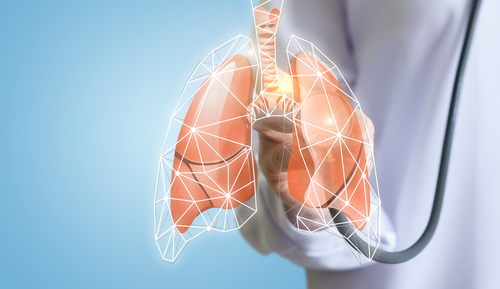Outcomes in PF-ILD Not Due to IPF Equally Poor, Real-World Study Finds
Written by |

Outcomes are as poor in people with progressive fibrosing interstitial lung disease (PF-ILD) other than idiopathic pulmonary fibrosis (IPF) as in those with IPF, according to a Japanese real-world study.
Researchers also found that worse lung function at a first assessment and the presence of fibrotic patterns in the lungs characteristic of IPF could raise the risk of disease progression in non-IPF ILD.
While these findings help in understanding the clinical features and potential risk factors of such PF-ILD in a real-world setting, larger studies are needed to confirm them, the team noted.
The study, “Clinical characteristics of non-idiopathic pulmonary fibrosis, progressive fibrosing interstitial lung diseases: A single-center retrospective study,” was published in the journal Medicine.
ILD is a group of more than 200 lung disorders in which the tissue in and around the air sacs becomes inflamed and scarred (fibrotic), affecting breathing and the lungs’ ability to transfer oxygen to the bloodstream.
Patients can develop a so-called “progressive fibrosing phenotype” (PF-ILD) that causes lung fibrosis, rapid lung function decline, and a person’s life quality and lifespan — similar to IPF, the most common ILD and the most typical example of PF-ILD.
Other examples include certain types of pneumonia, ILDs associated with inhaling potentially harmful substances, such as chronic hypersensitivity pneumonitis, and connective tissue disease-associated ILDs, such as those caused by scleroderma and rheumatoid arthritis.
Boehringer Ingelheim’s oral therapy Ofev (nintedanib) became in 2020 the first approved treatment for PF-ILDs other than IPF in the U.S. and Canada, as well as in Europe. Ofev was approved to treat IPF in 2014.
“However, the clinical features of non-IPF, PF-ILD in a real-world setting remain unknown,” the researchers wrote.
A team in Japan now described the clinical features and survival outcomes of 11 people with non-IPF PF-ILD, compared with those of 34 IPF patients and 46 people with a non-progressive ILD, all being treated at Shinshu University Hospital in Matsumoto.
Patients had all undergone at least two lung function assessments with an interval of at least two years between January 2009 and December 2015. A diagnosis of progressive ILD was defined as a decline of at least 10% in forced vital capacity (FVC), or an FVC drop of at least 5% with a decline of 15% or more in diffusing capacity of the lung for carbon monoxide (DLCO) over two years.
Of note, FVC represents the total volume of air that can be blown forcefully following a full inhalation, while DLCO refers to the lung’s ability to transfer oxygen to the bloodstream.
Patients’ medical records were retrospectively analyzed by the researchers, and their characteristics, treatment status, and survival were compared with IPF and non-IPF patients, and between the non-IPF, PF-ILD and non-progressive ILD groups.
Among non-IPF patients who were classified as having a progressive disease, four had ILD associated with pneumonia and three with connective tissue diseases, while two others had pleuroparenchymal fibroelastosis, and one had a different type of ILD.
IPF patients were significantly older and had poorer lung function at the second assessment than did non-IPF patients. A significantly greater proportion of IPF patients also showed a 15% or greater decline in DLCO over two years, highlighting faster disease progression.
People with PF-ILD other than IPF showed significantly worse lung function at the first and second exams than did those without progressive disease, and more frequently exhibited the usual interstitial pneumonia-like fibrotic pattern — characteristic of IPF — in their lungs (54.5% vs. 13%).
Further analysis suggested that low %FVC at a first lung function assessment and the presence of IPF-characteristic fibrotic pattern might be risk factors of progressive disease in people with non-IPF ILD.
“Thus, the pulmonologist should administer additional treatment before disease progression,” such as Ofev, the researchers wrote.
Notably, six (54.5%) of the 11 patients with non-IPF PF-ILD were not being given a treatment at the time of these assessments, despite a clear deterioration in lung function.
In these cases, pharmacological treatment may not have been administered due to concerns for the side effects associated with immunosuppressive therapies, or a lack of effective treatments at that point, the researchers noted.
People with PF-ILD other than IPF also had significantly poorer survival than those without progressive disease, comparable to that of the IPF group.
The team noted that IPF patients’ survival was better than that reported in previous studies, possibly because patients with faster disease progression may not have been included in this study.
Additional analysis highlighted that older age and low %DLCO at a first assessment were significantly associated with a higher risk of death among non-IPF patients.
“The prognosis of non-IPF, PF-ILD patients was as poor as that of IPF patients,” the researchers wrote, adding that “non-IPF, PF-ILD patients require more intensive treatment before disease progression, and [Ofev] might be an option.”
Future prospective and larger studies with well-defined goals are needed to confirm these findings, the team added.






